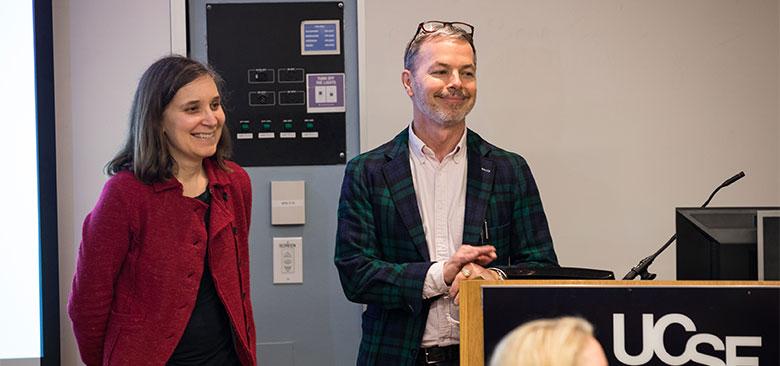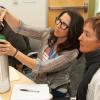
In the course "Substance Abuse and Mental Illness," assistant professor Annesa Flentje and professor Matt Tierney help students identify underlying causes of substance use such as inadequate housing and discrimination. (Photo by Elisabeth Fall)
Amid Substance Use Epidemic, New Research and Training Aims to Stem Tide
With nearly 19 million U.S. adults – about one in 12 – struggling with substance use disorder, researchers at the UCSF School of Nursing are exploring innovative remedies – pharmacological, cognitive, and even exercise-based interventions paired with an employment incentive – to stem the nation’s substance use epidemic.
Curbing Methamphetamine Use
While substance use affects all age groups and across socio-economic levels and backgrounds, the LGBTQ community has a higher prevalence of use relative to the general population. According to a 2015 National Survey on Drug Use and Health, lesbian, gay or bisexual adults were more likely than heterosexual adults to have disorders involving illicit substances (39.1 percent to 17.1 percent), marijuana (30.7 percent to 12.9 percent), and prescription pain relievers (10.4 percent to 4.5 percent).
“There’s research that shows LGBT populations don’t feel as comfortable in substance use treatment programs and have reported it’s not an inviting and welcoming space,” said Glenn-Milo Santos, associate  Glenn-Milo Santos professor in the School of Nursing.
Glenn-Milo Santos professor in the School of Nursing.
There’s also a need to examine effective pharmacologic treatments for substance use disorders. To address these gaps, Santos’ current research combines pharmacological and counseling approaches to treat substance use, including cocaine, alcohol and methamphetamine.
Santos recently co-first authored a study examining the effects of mirtazapine, an antidepressant, with counseling on methamphetamine users who are cisgender men (individuals identified as male at birth), transgender men (individuals identified as female at birth, but now identify as male), and transgender women (individuals identified as male at birth, but now identify as female). There have been no pharmacologic agents approved for methamphetamine use disorders, but a 12-week trial with mirtazapine that Santos conducted prior to this study, had encouraging results.
Those encouraging results were seen again in a recently completed larger trial. The rate of methamphetamine-positive urine tests “significantly declined among participants randomized to mirtazapine vs. placebo.” The decline was evident after 24 weeks of treatment, and sustained through 12 weeks of follow-up treatment after participants stopped taking mirtazapine.
Serotonin and dopamine levels increase due to acute use of methamphetamine. When individuals stop using the substance, those levels decrease, triggering methamphetamine craving and impulsive drug-seeking.
“When a chronic user of methamphetamine cuts down their use, they might experience withdrawal symptoms,” Santos said. “Because their levels of dopamine and serotonin are dysregulated, they might feel tired or lack the ability to feel pleasure, and they may crave or seek out more methamphetamine in order to reduce these symptoms.”
Mirtazapine restores serotonin and dopamine levels in specific parts of the brain linked to the cycle of substance use disorders, Santos explained. As those levels are restored, Santos postulates that methamphetamine cravings and withdrawal symptoms will be eased.
Mirtazapine may have an added benefit for populations with high burdens of HIV and STI transmission – men who have sex with men. Santos said research has linked methamphetamine use to sexual behaviors, including condomless sex with a greater number of sexual partners. If methamphetamine use is reduced in this population, that could also result in the decline of condomless sexual behaviors, which could lead to fewer HIV transmissions. Santos’ two mirtazapine studies have indicated parallel reductions in condomless sex associated with reductions in methamphetamine use, supporting this hypothesis.
Santos hopes these findings accelerate the FDA’s approval of mirtazapine for methamphetamine treatment, help scale up efforts to treat methamphetamine, as well as expand options to reduce HIV transmission associated with methamphetamine among sexual and gender minorities.
Combining Exercise With Potential Employment
Because exercise is good for your health, it stands to reason that it can be beneficial for individuals with substance use disorders.
 Heather Leutwyler, Erin Hubbard A recent study by School of Nursing associate professor Heather Leutwyler, senior clinical research coordinator Erin Hubbard, and Maria Stevens, Director of the Live Fitness Program for the Salvation Army’s Harbor Light Center, took that premise even further. What if, in addition to substance abuse counseling and an exercise program, individuals also underwent vocational training?
Heather Leutwyler, Erin Hubbard A recent study by School of Nursing associate professor Heather Leutwyler, senior clinical research coordinator Erin Hubbard, and Maria Stevens, Director of the Live Fitness Program for the Salvation Army’s Harbor Light Center, took that premise even further. What if, in addition to substance abuse counseling and an exercise program, individuals also underwent vocational training?
Live Fitness is a voluntary, 12-week program where individuals in a residential substance abuse treatment program learn about the value of exercise through classes and physical training. Thirty-four of 53 participants in the study graduated from the program and completed six months of sobriety.
Maintaining sobriety and gaining employment can be difficult for individuals who battled substance use, especially if it resulted in getting arrested or going to prison. To help them succeed, participants who complete the course in good standing are eligible for employment at the fitness center. The majority of participants who earned positions with the fitness center began at the front desk or café, but others have become – or are on track to become – personal trainers. One graduate secured a job in membership sales.
The opportunity for employment was integral to the program’s success.
“They’re not only learning the importance of exercise and using exercise to cope with withdrawal and cravings, but now they’re also given this opportunity to potentially have a job,” Leutwyler said.
Participants also commented that the fitness center’s staff, particularly those who are program graduates, served as motivation for recovery.
“With the program alumni there as role models, the behavior got better and better,” said Stevens, who is a former research assistant at UCSF’s Cardiovascular Research Institute. “People need to have something to work toward. Sobriety is awesome, but where do you go with that sobriety? How will you put food on the table? We want to show there’s a future in front of them.”
Training Nurses to Identify, Treat Substance Use and Mental Illness
At the School of Nursing, faculty are training nurses to be aware of the high prevalence of substance use and equipping them with the skills to provide effective, personalized care to patients battling substance use and a psychiatric disorder.
 Annesa Flentje “We want to get health care providers up to speed on how to help patients who have substance use problems in the context of other health problems,” said assistant professor Annesa Flentje, whose research includes cognitive-behavioral interventions to reduce substance use by targeting minority stress.
Annesa Flentje “We want to get health care providers up to speed on how to help patients who have substance use problems in the context of other health problems,” said assistant professor Annesa Flentje, whose research includes cognitive-behavioral interventions to reduce substance use by targeting minority stress.
 Matt Tierney A key to dealing with those other health problems is understanding their underlying causes. Housing, income, access to health care and discrimination based on race, sexual orientation and gender identity are among the sociocultural factors that can lead to and exacerbate substance use.
Matt Tierney A key to dealing with those other health problems is understanding their underlying causes. Housing, income, access to health care and discrimination based on race, sexual orientation and gender identity are among the sociocultural factors that can lead to and exacerbate substance use.
Flentje and professor Matt Tierney are bringing these issues to the forefront through their “Substance Use and Mental Illness” course, providing important context for nurses to consider.
The class provides three main care strategies. The first is a patient-centered approach, connecting and engaging with, as Tierney states, “a patient who has been traditionally marginalized in the medical and health care system.” The second approach is using cognitive behavioral tools and motivational interviewing to induce behavior change. The third approach is understanding and offering effective medication treatments. Nurse practitioners then develop a patient plan using tools from one or all approaches.
The challenge is that not all nurse practitioners are allotted the time and freedom to formulate these customized patient plans so Flentje recommends prioritizing quality over quantity.  Bill Buehlman, outreach coordinator for GLIDE, was a guest speaker in the Substance Abuse and Mental Illness course.
Bill Buehlman, outreach coordinator for GLIDE, was a guest speaker in the Substance Abuse and Mental Illness course.
“Even very brief interventions can have profound effects on behavior change,” she said. “My goal is to really empower them with the idea that they don’t need a 45-minute session week after week after week to help a patient make change. They have to work with what they have, be flexible, and carefully think about what they do in those brief interactions because they can have a huge impact.”



